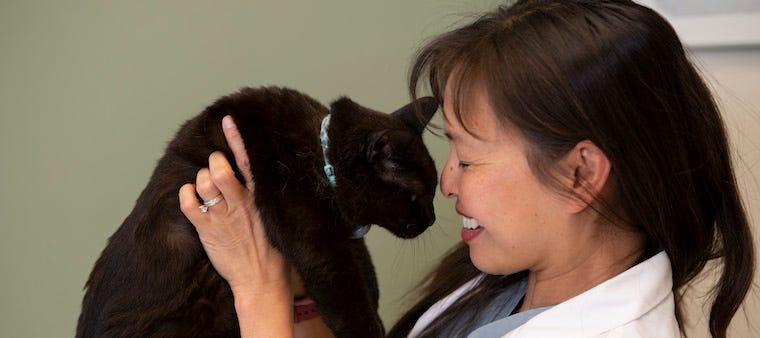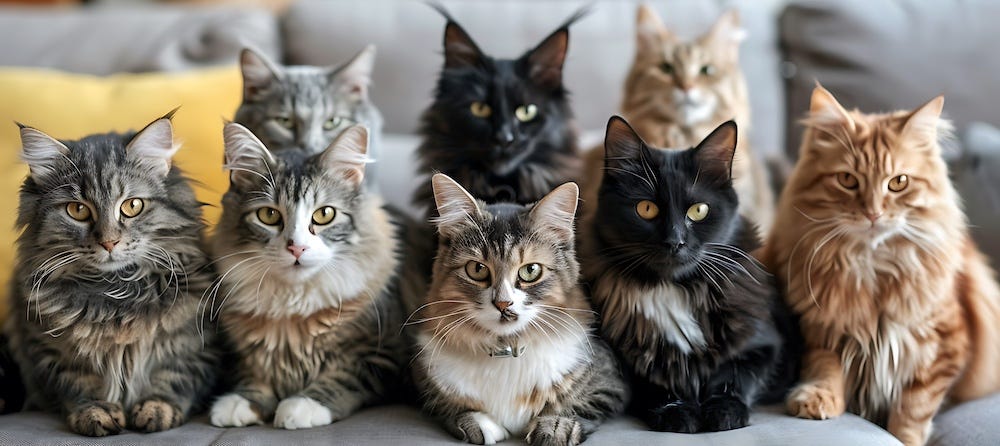Kidney disease in cats is prevalent. If your cat was just diagnosed with kidney or “renal” disease, read on!
The kidneys are normally vital in eliminating wastes from the body, concentrating urine, and balancing the amount of water and electrolytes (such as salt) in the body. If the kidneys malfunction, it can result in two types of disease: acute or chronic. Acute kidney injury (AKI) results in severe injury to the kidneys and can lead to sudden demise, where the kidneys shut down. Aggressive treatment at a 24/7 veterinary facility is typically required, to help minimize the risk of death. Chronic kidney failure (often called chronic renal failure or CRF) occurs slowly, and cats may be able to compensate with this for months to years. Signs may be milder and more progressive. With appropriate diagnosis, nutrition, monitoring, and treatment, cats can potentially live with chronic kidney disease for years.
I should know: My own 19-year-old furbaby lived with it for about 6 years before succumbing to an unrelated illness (mouth cancer/squamous cell carcinoma).
That said, cat owners must be aware of chronic renal disease, as it is one of the top causes of mortality.
What are signs of kidney disease in cats?
Clinical signs of chronic renal failure in cats include:
- Excessive drinking
- Excessive urination (e.g., larger clumps in the litter box, bigger than the size of my fist—yes, a petite female’s fist)
- Muscle wasting (especially over the back)
- Weight loss
- Bad breath (due to kidney poisons building up in the blood and causing ulcers in the mouth, esophagus, and stomach)
- Ulcers in the mouth
- Sudden blindness or dilated pupils
- Unusual appearance to the eyes (due to high blood pressure and retinal injury)
- Drooling
- Lethargy
- Heat seeking (due to low body temperature)
- Dehydration (seen as excessive skin tenting)
- Pale gums (secondary to anemia)
- Decreased appetite
- Hiding
- Weakness
- Twitching (in severe, undiagnosed cases)
- Seizures (in severe, undiagnosed cases)
How do you diagnose kidney disease in cats?
The diagnosis of CRF is based on physical examination and blood/urine tests. In my opinion, any cat over 10 years of age should have blood tests done when visiting your veterinarian. And yes, that’s every single year (see why below).
This should include the following tests:
- Complete blood count (CBC), which looks at the red and white blood cells (looking for anemia), platelet count, etc.
- Chemistry panel, which looks at the kidney and liver function, salt balance, blood sugar, and protein
- Urinalysis (obtained by sterile technique or cystocentesis), which looks for red and white blood cells, protein, or the presence of bacteria in the urine
- T4 (a thyroid test), which looks to see if your cat has an overactive thyroid gland
- Urine culture (the most accurate way of detecting if there’s a bacterial urinary tract infection or “UTI”)
- Urine protein: creatinine test (to look at the level of protein loss in the kidneys)
- Blood pressure monitoring (with normal being similar to humans at 120 mm Hg)
- Kidney biopsies (less commonly done)
BUN, creatinine, and urine specific gravity
Most importantly, I’m looking at three main tests: BUN, creatinine, and the urine specific gravity (which is the body’s ability to concentrate urine, with normal being > 1.050). When the BUN and creatinine blood tests are elevated, that means that kidney injury has occurred; typically, 75% of both the kidneys are no longer functioning well, hence, the elevation in these two kidney tests. (More recently, a test by Idexx found that SDMA, a newer kidney test, picks up on kidney injury earlier, and is thought to detect when 25% of kidney function is gone). Please note that sometimes BUN, creatinine, urine concentration, and SDMA tests can be abnormal from other diseases like dehydration, hyperthyroidism, diabetes mellitus, feline urethral obstruction, certain medications, or even the administration of fluids under the skin.
Most of the time, elevations in the BUN/creatinine and SDMA indicate kidney disease and should be evaluated acutely by your veterinarian. With significant elevations, hospitalization may be necessary to put your cat on IV fluids to get the renal tests down as low as possible. Again, keep in mind that these blood tests may be elevated from kidney poisons (such as Easter lilies and other types of lilies), temporarily from having a urinary obstruction, or even from underlying kidney infections (which may have started as a bladder infection that migrated up to the kidneys, called “pyelonephritis”).
Causes for kidney disease in cats
Elevated blood tests or abnormal results may warrant additional testing. These may include X-rays of the abdomen (to rule out kidney or bladder stones), or even an abdominal ultrasound (to look at the architecture or “inside” of the organs). A veterinary specialist may need to do this additional work-up. That’s because there may be other underlying causes of CRF in cats, including:
- Pyelonephritis (an infection in the kidneys)
- Glomerulonephritis (disease of the filtering unit of the kidneys)
- Cancer
Less common causes include:
- Polycystic kidney disease (an inherited disease affecting kidney tissue, seen more in Persian cats)
- Feline infectious peritonitis (FIP)
- Amyloidosis (an inherited disease in Oriental cat breeds)
- Ureteral obstruction (stones in the tube from the kidneys to the bladder)
Treatment for kidney disease in cats
Thankfully, with appropriate management, cats can live with CRF for years (unlike dogs, who have a poorer response to therapy). Depending on how elevated the kidney blood tests are, how high your cat’s blood pressure may be, and how much protein your cat is losing into their kidneys, we may start a low-phosphorous, lower-protein diet, along with certain medications to minimize protein loss in the kidneys (e.g., benazepril) and to help lower the blood pressure (e.g., amlodipine). In general, therapy should be based on the newest International Renal Interest Society (IRIS) guidelines, which are created by the leading veterinary nephrologists out there.
Other chronic management may include frequent blood work, increasing water intake (such as with a water fountain or by feeding a gruel-type canned food), and even fluids under the skin (which many pet owners do at home, once properly trained).
Keep in mind that the sooner we veterinarians diagnose renal disease, the sooner we can treat CRF in your cat and the better the long-term prognosis. With appropriate care and treatment, cats with CRF can live a long, healthy life. With supportive care, the prognosis for CRF is fair. However, it does require once- or twice-a-year blood work for the rest of your cat’s life.
Prevention
So, is there anything you can do to prevent chronic renal failure in cats? Honestly, not really. With the exception of a few helpful hints below, CRF is often due to scarring, injury, or potentially even inherited causes. There are a few things you can do to prevent CRF in cats, including:
- Keeping poisons like Easter lilies (e.g., Hemerocallis or Lillium spp.) out of reach
- Making sure your cat has fresh water available at all times (or even bottled water if you use well water or potentially high-mineral content water sources)
- Weaning your cat onto canned food, especially as they age, so you can gradually increase their water intake by grueling more warm water into their canned food
- Making sure your cat gets an annual examination at your veterinarian, especially as they turn over 10 years of age
- Getting annual blood work done at your veterinarian (including an annual blood pressure)
One of the reasons why annual veterinary visits are a must, especially as your cat ages, is to help detect problems sooner. The sooner CRF is diagnosed, the sooner it can be treated. Most importantly, if you notice any of the signs of CRF (e.g., excessive thirst, excessive urination), please bring your cat into your veterinarian as soon as possible.
Key definitions/abbreviations:
CKF: chronic kidney failure
CRF: chronic renal failure
IRIS: International Renal Interest Society
Recommendations









